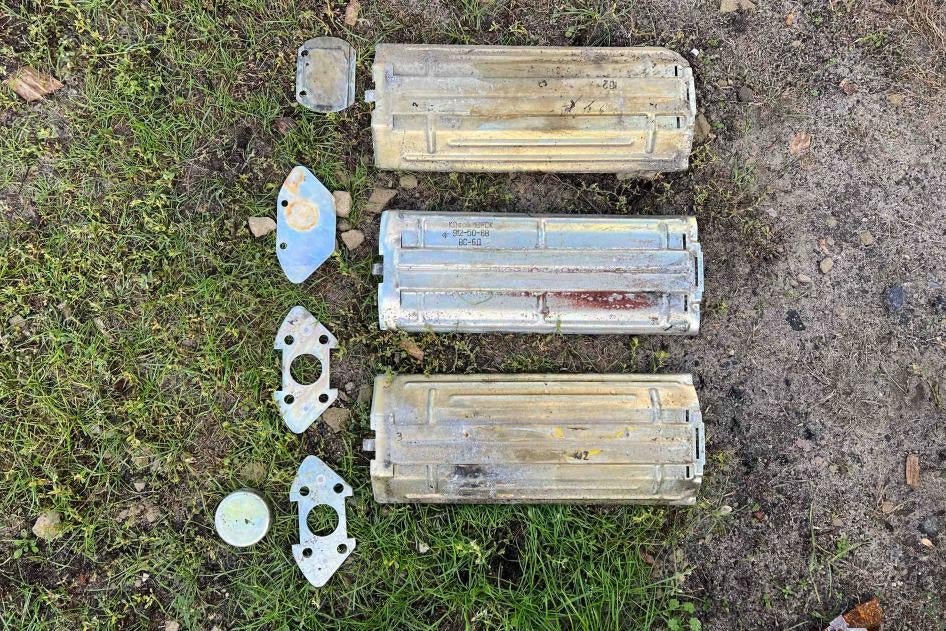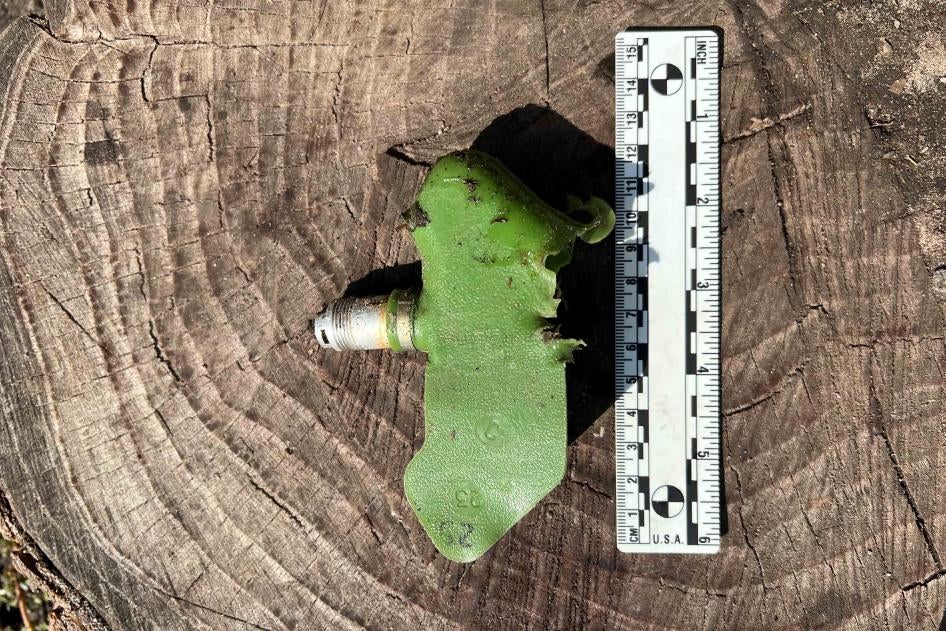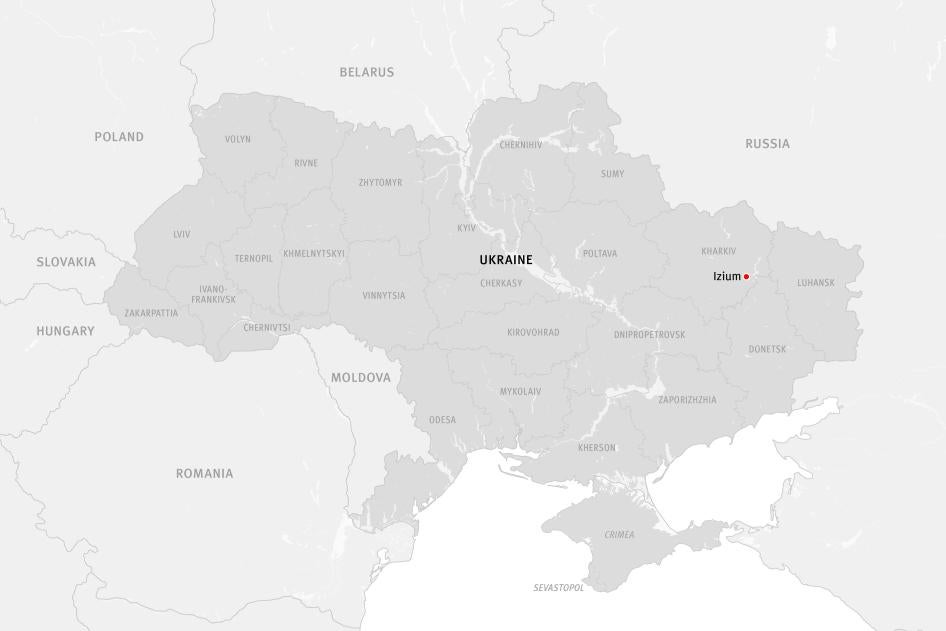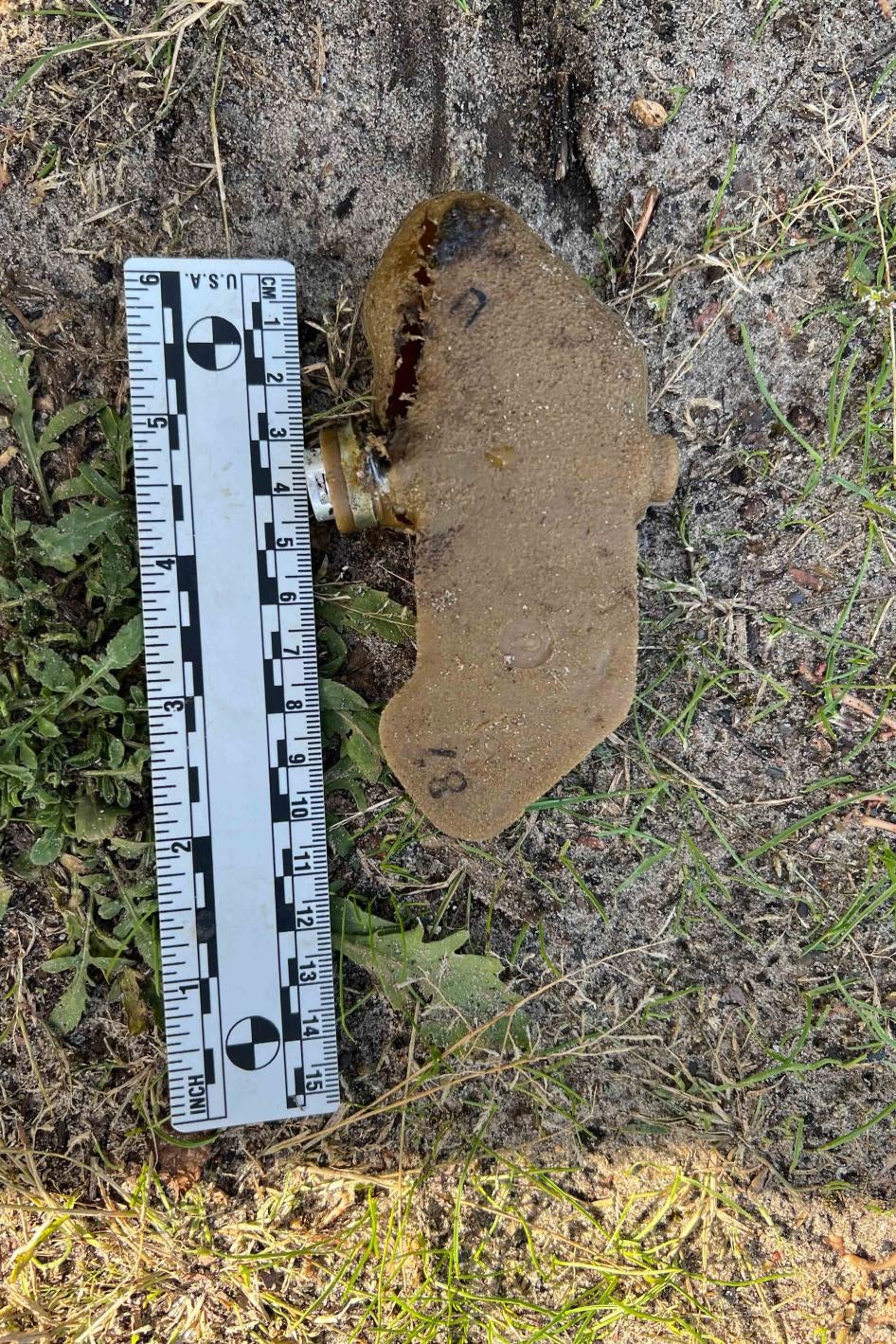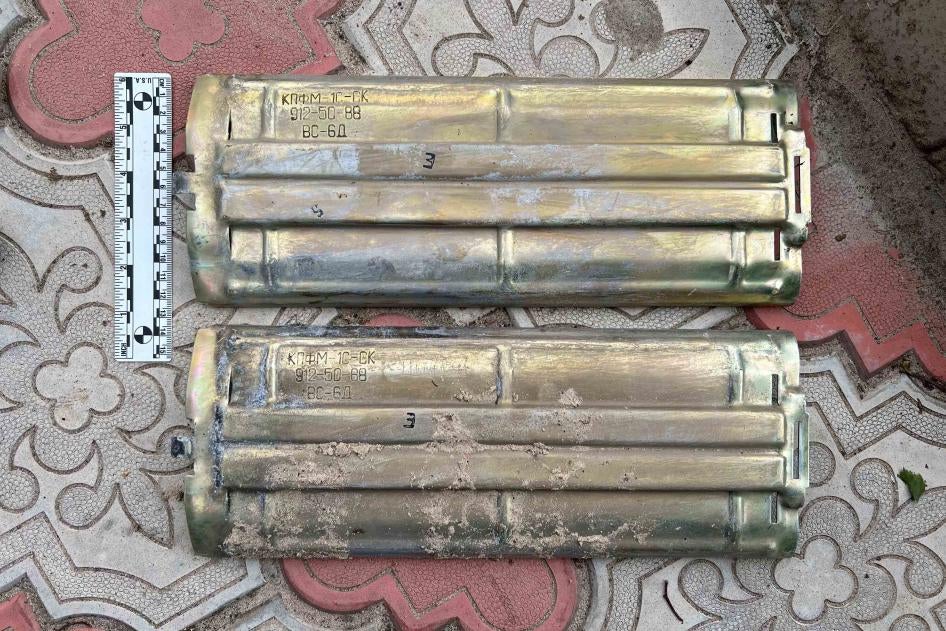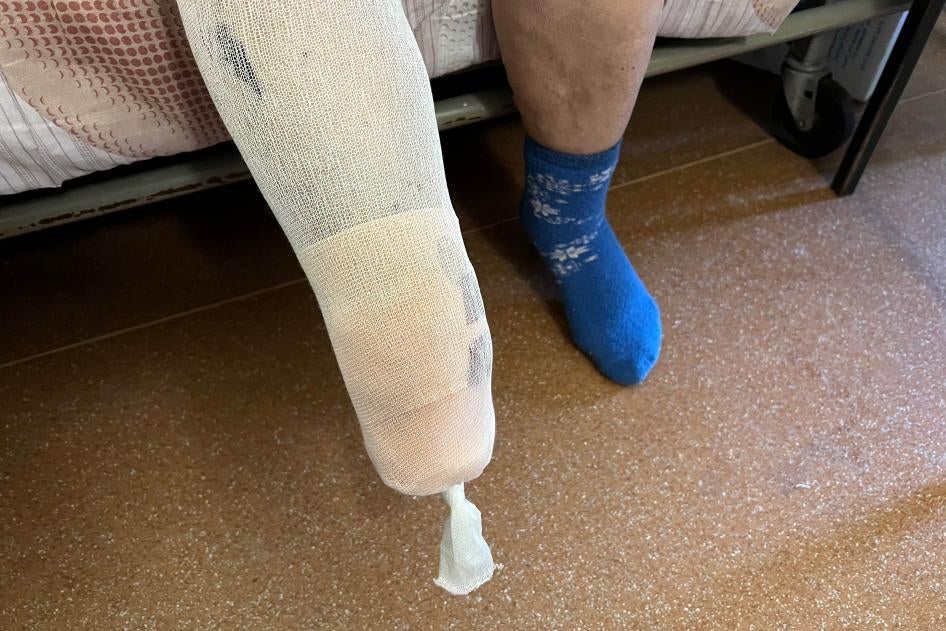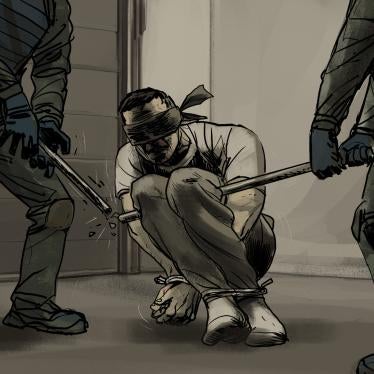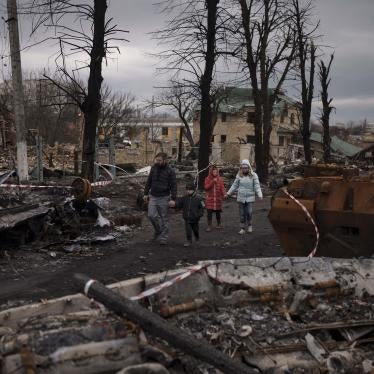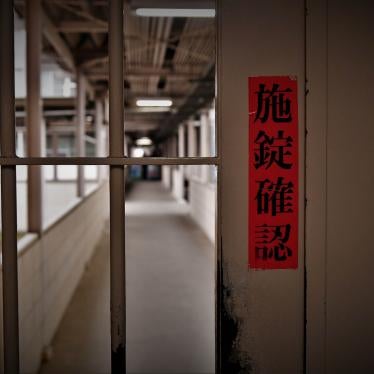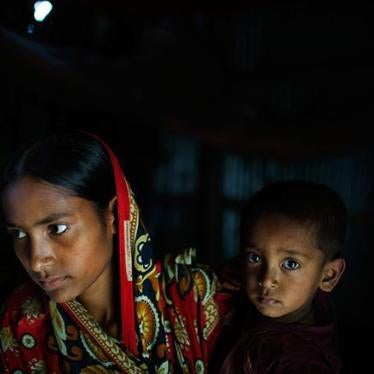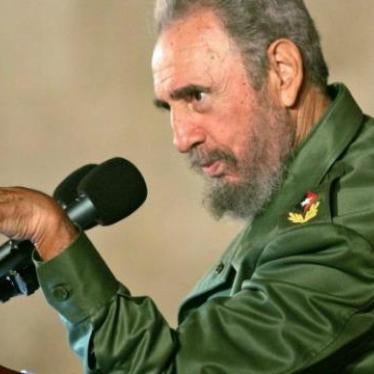(キーウ)ウクライナ政府は、東部の都市イジュームとその周辺で、ロシア軍がこの地域を占領していた時期に、ウクライナ軍がロケット発射型対人地雷数千個を使用したと見られることを調査すべきだと、ヒューマン・ライツ・ウォッチは本日述べた。
ヒューマン・ライツ・ウォッチは、PFM型対人地雷(通称「バタフライ地雷」や「花びら地雷」。以下「PFM地雷」)を搭載したロケット弾が、ロシア占領地域のロシア軍施設近くに発射された事例を多数記録した。ウクライナは、対人地雷の使用を禁止する1997年の対人地雷禁止条約(オタワ条約)の批准国である。
ロシア軍は、2022年2月24日のウクライナへの全面侵攻以来、被害者が作動させるブービートラップ型を含む対人地雷を、ウクライナ全域の多数の地域で使用している。ヒューマン・ライツ・ウォッチはこれまでに、ロシア軍が2022年にウクライナで対人地雷を使用したことを明らかにした3つの報告書を発表した。
「ウクライナ軍はイジューム一帯に広範囲に地雷を散布し、民間人に犠牲者を出し、継続的なリスクを生じさせているとみられる」と、ヒューマン・ライツ・ウォッチの武器局長スティーブ・グースは指摘した。「ロシア軍はウクライナ国内で対人地雷を繰り返し使用し、残虐行為を続けている。しかし、だからといって、ウクライナ政府が対人地雷のような禁止兵器を使用してよいことにはならない」。
大半の対人地雷が人間の手で敷設されるのに対し、イジューム一帯で使用されたPFM地雷は、航空機、ロケット弾、砲で散布されるか、専用の車両や発射装置から発射されることで効力を発揮するタイプである。対人地雷の使用は、この兵器が民間人と戦闘員を区別できないため、国際人道法に違反する。地雷が除去されていないと、その地域を去る人が増え、人道援助の提供が妨げられ、農業を営めなくなる。
ロシア軍はイジュームとその周辺地域を4月1日までに占領し、9月初旬にウクライナ軍が反攻を開始するまで全面的に支配していた。占領中、ロシア軍は住民を恣意的に拘束し、尋問や拷問を行った。民間人を強制的に失踪させ、殺害した事例もある。
ヒューマン・ライツ・ウォッチは、9月19日から10月9日までイジューム地区で調査を行い、地雷使用の目撃者、被害者、ファーストレスポンダー(現場に急行する職務の人びと)、医師、ウクライナの地雷除去作業員など100人以上にインタビューを行った。インタビューした全員が、地表にある地雷を見かけたか、地雷で負傷した人を知っているか、ロシアのイジューム占領中に地雷の存在について警告を受けたことがある、と答えた。
ヒューマン・ライツ・ウォッチは、イジュームの町とその周辺の9つの地域で、PFM地雷の使用を記録し、民間人11人が被害を受けたことを確認した。
医療従事者によると、ロシア軍占領中から占領後にかけて、この地域で、対人地雷で負傷したと見られる民間人約50人(少なくとも5人の子どもを含む)が治療を受けた。負傷者の約半数は、足または下肢の外傷性切断を伴う。これはPFM型炸裂地雷がもたらす負傷と整合性がある。ロシア軍兵士が地雷散布目的のロケット弾攻撃で死傷したかについては、調査員は確認できなかった。
「そこら中にある」と、ウクライナの地雷除去作業員の1人は、イジューム一帯のPFM地雷についてこう述べた。地雷やその他の不発弾を除去するには、数十年かかるかもしれない、と除去作業員たちは見積もっている。
ヒューマン・ライツ・ウォッチは、イジュームとその周辺の9地域のうち7地域で、PFM地雷が使用された物的証拠を確認した。起爆していない地雷、地雷の残骸、ロケット弾に地雷を搭載するための金属製カセットなどだ。いくつもの場所で、調査員はPFM地雷に含まれる爆薬の量と整合性のある爆風の痕跡を実際に確認した。残りの2地域では、PFM地雷の形状と一致する地雷を見たという証言がいくつもあった。
上記9地域のうち6地域で、ロケット弾散布による地雷と一致する攻撃を目撃したとの証言があった。ヒューマン・ライツ・ウォッチは、イジューム地区の3カ所で、地雷散布も可能なBM-27「ウラガン」型自走式多連装ロケットランチャーが発射するロケット弾のモーターが地面に刺さっていたり、建物に当たっていたりする状況を確認した。その様子は、当該ロケット弾が、攻撃の時点で、ウクライナ軍支配地域から飛来した、当該ロケット弾の最大射程35km以内のものであることを示している。
これら9地域はすべて、当時ロシア軍が展開していた場所に近いことから、標的はロシア軍だったことが示唆される。ロシア軍は9月上旬にこれらの陣地から撤退中だったが、ヒューマン・ライツ・ウォッチが記録した9月9日と10日の2回の攻撃は、目撃証言によれば、ロシア軍がまだ残留していた段階で行われている。
イジュームとその周辺の住民100人以上が、ロシア軍や占領当局が地雷の危険性を警告するチラシを掲示、配布したと述べている。またロシア軍や占領当局は、公共の場所や民間人の私有地から地雷を除去し、地雷被害者の一部を治療のためにロシアに移送した。地雷を敷設した側の行動であるならば一貫性がないものだ。ヒューマン・ライツ・ウォッチは、ロシア軍に軍用ヘリコプターでロシアに移送され、治療を受けたという地雷被害者2人から話を聞いている。
ヒューマン・ライツ・ウォッチは、ロシアがウクライナでPFM以外の対人地雷を使用していることを記録しているが、ロシア軍が武力紛争でPFM地雷を使用したとの疑いについては確認できなかった。
1997年の対人地雷禁止条約は、対人地雷を包括的に禁止し、貯蔵地雷の破棄、敷設地雷の除去、被害者への支援を義務づけている。ウクライナは1999年2月24日に同条約に調印し、2005年12月27日に批准した。ロシアは条約未加盟だが、対人地雷がもたらす被害の無差別性を踏まえると、その使用はやはり国際法違反である。対人地雷禁止条約は1999年3月1日に発効し、米国を除くすべてのNATO(北大西洋条約機構)加盟国とすべてのEU(欧州連合)加盟国を含む164カ国が加盟している。
ウクライナは、ソ連崩壊により対人地雷の在庫を大量に引き継いだ。同国は1999年から2020年にかけて、PFM地雷を含む対人地雷340万個以上を廃棄した。2021年、ウクライナは国連事務総長に対し、貯蔵するPFM地雷330万個の破壊がさらに必要だと報告した。ウクライナ政府高官筋によると、ウクライナがいまだ備蓄する対人地雷は、9M27K3 220mmロケット弾(注:上記「ウルガン」で発射可能なロケット弾)に搭載されたPFM地雷のみだ。ヒューマン・ライツ・ウォッチは以前、2014年と2015年にウクライナでロシアに支援された武装組織が対人地雷を使用したことを記録している。
対人地雷禁止条約第20条2項によれば、締約国が武力紛争に巻き込まれている場合、武力紛争が終了するまで同条約から脱退することができない。また、同条約は留保ができない。
ヒューマン・ライツ・ウォッチは11月3日、ウクライナ国防省と外務省、大統領府に対し、イジューム周辺でのPFM地雷使用に関する一連の質問を提出し、会談を要請した。また複数の政府関係者に連絡を取り、会談を行うよう働きかけた。
11月23日、国防省は書面で回答を行い、軍は対人地雷の使用禁止を含む、自国が拘束される国際的義務を遵守しているとした。しかし、イジュームおよび周辺でのPFM地雷使用に関する一連の質問には回答せず、「ウクライナが使用する兵器の種類に関する情報(略)は、戦争終結前にコメントできない」と記した。
2022年11月24日の対人地雷禁止条約第20回締約国会議で、ウクライナは条約の「責任ある締約国」であり、貯蔵する対人地雷を防衛目的で使用することは「一度も検討したことがない」と述べている。
ウクライナは、対人地雷禁止条約が対人地雷の使用を厳格に禁止していることを改めて確認し、PFM地雷が最近使用された疑いがあることについて調査を開始し、責任者の法的責任を追及し、貯蔵する対人地雷を安全に保管し、破棄する措置を取るべきだと、ヒューマン・ライツ・ウォッチは述べた。ウクライナはまた、対人地雷被害者の特定と支援に努めること、具体的には適切で時宜を得た補償、医療をはじめとする各種の支援(心理社会的支援を含む、適切かつ継続的なリハビリを伴う装具の提供など)を行うことが求められる。
ロシアは、対人地雷の無差別性を踏まえ、その使用を停止するとともに、自軍の使用状況を調査し、対人地雷禁止条約に加盟すべきであると、ヒューマン・ライツ・ウォッチは述べた。
ヒューマン・ライツ・ウォッチは、地雷禁止国際キャンペーン(ICBL)の共同創設者であり、共同議長を務めている。ICBLは1997年のノーベル平和賞の共同受賞者である。
「対人地雷のいかなる使用も違法である。ウクライナは実態を徹底的に調査し、自軍が対人地雷を使用しないようにすべきである」と、前出のグース局長は述べた。「当局はまた、この無差別兵器によって死傷したすべての民間人やその家族への支援を確実に行うべきである。」
For more information on the landmine incidents documented by Human Rights Watch and the Ukrainian government’s response, please see below.
PFM mines, also called “petal” or “butterfly” mines, are small plastic blast mines that are fired into an area, land on the ground and detonate when pressure is applied to the body of the mine, for example when someone steps on it. The PFM mine can also detonate upon being handled or moved. Some PFM mines can self-destruct, exploding randomly up to 40 hours after being used. Antipersonnel mines explode by the presence, proximity, or contact of a person, and can kill and injure people long after armed conflicts end.
All the witnesses interviewed described the same type of mine. Some described the mine’s colors, physical characteristics, and the way it operated. Many of those interviewed said they had seen mines on the ground and showed researchers the physical remnants. Others identified an image of PFM antipersonnel mines after describing what they had seen.
Areas and Time Periods of PFM Mine Use in Izium District
|
|
Village/City |
Area |
Date of Discovery |
|
1 |
Kapytolivka Village, east of Izium |
Village center |
Late April |
|
2 |
Izium |
Central District/along Heroiv - Chornobyltsiv Street |
Early June |
|
3 |
Izium |
Central District/near Kindergarten No. 12 |
Summer |
|
4 |
Izium |
Central District/Izium Central Hospital |
Mid-July/Late Summer |
|
5 |
Izium |
Central District/Southern Izium |
Mid-July/Early August |
|
6 |
Izium |
Central District/northern part of Right Bank |
July/Mid-August |
|
7 |
Hlyns'ke Village, northwest of Izium |
Western edge of village |
Late August |
|
8 |
Izium |
Neighborhood south of Shekspira Street |
September 9/10 |
|
9 |
Izium |
Neighborhood around School No. 6 |
September 10 |
General areas and time periods when witnesses observed antipersonnel mines in and around Izium. Human Rights Watch corroborated the time period for each incident with multiple individuals. Researchers either observed remnants directly in these areas or witnesses said they saw the PFM-series antipersonnel mines, with the aid of reference materials. In each location, witnesses observed or reported at least several mines.
Uragan-series rockets have a range of 10 to 35 kilometers. Throughout the duration of the Russian occupation of Izium and the surrounding area, Ukrainian forces controlled territory to the northwest, west, southwest, and south, close enough to enable them to target Izium with Uragan-series artillery rockets carrying submunitions and the PFM mines.
Russian forces also controlled territory around Izium for the duration of the occupation from which they would have been able to fire rocket artillery from a minimum of 10 kilometers away and into areas occupied by its forces and Ukrainian civilians. However, a scenario in which Russia, repeatedly over the course of five months, used antipersonnel landmines against its own troops and across territory it hoped to control permanently is highly unlikely.
Izium residents said that they began seeing Ukrainian forces in the central part of Izium city either late on September 10 or on September 11. Human Rights Watch did not document any PFM mine use in the area after that date.
Rocket Delivery of PFM Antipersonnel Mines
PFM antipersonnel mines can be deployed in various ways: by hand-carried ground launchers, vehicle-mounted launchers, fixed-wing aircraft and helicopters, and ground-fired 122mm Grad and 220mm Uragan rockets. Human Rights Watch did not find any remnants of the KSF-1 series cassettes or BKF-PFM cassettes required to deliver these mines using platforms other than rockets, such as a truck or air-delivered methods or the use of hand-carried ground launchers.
The 220mm 9M27K3 Uragan mine-laying rocket opens in flight using a small explosive charge to separate it from the rocket motor section of the weapon and scatters 312 PFM mines into an area. Human Rights Watch researchers found several unique types of cassettes, including KPFM-1S-SK, used for the delivery of PFM mines by 220mm Uragan rockets.
Human Rights Watch spoke to witnesses whose descriptions of PFM mine use in six areas were consistent with that of rocket delivery. Each witness described hearing a rocket or an explosion followed either by the sound of the mines hitting or “slapping” the ground or building roofs or observing them for the first time in the minutes following the in-air-explosions of the rockets, which many residents mistook for a cluster munitions attack, which would disperse dozens of small submunitions that are designed to detonate upon impact. Residents in Izium told Human Rights Watch that rocket attacks happened frequently during the Russian occupation. Human Rights Watch is investigating allegations of the use of rocket-delivered cluster munitions in Izium and the surrounding territory during the Russian occupation of these areas.
Areas and Time Periods When Rocket Attacks Were Observed
|
|
Village/City |
Area |
Date |
|
1 |
Kapytolivka Village, east of Izium |
Village center |
Late April |
|
2 |
Izium |
Central District/ Izium Central Hospital |
Mid-July |
|
3 |
Izium |
Central District/ Southern Izium |
Mid-July |
|
4 |
Izium |
Central District/ northern part of Right Bank |
July |
|
5 |
Izium |
Neighborhood south of Shakespeare Street |
September 9 |
|
6 |
Izium |
Neighborhood around School No. 6 |
September 10 |
In another distinct area where PFM mines were used, Human Rights Watch did not speak to witnesses who had observed the moment of delivery, but physical evidence indicates that mines in this area were also delivered by rocket.
Human Rights Watch researchers found rocket motor sections of Uragan series rockets of the kind that are capable of carrying submunitions, as well as the PFM mines in cassettes, that were stuck in the ground or otherwise struck buildings in such a way to indicate they came from the south and west of the Izium area, where Ukrainian forces had control of the territory. Repeated firing of rocket artillery at the city of Izium from late February to early September, and ongoing demining operations by both Russian and Ukrainian forces, prevented Human Rights Watch from determining which rocket motor or carrier section was associated with each attack.
Civilian Casualties
Human Rights Watch verified 11 cases of civilian casualties from PFM mines in and around Izium. Four lost their foot or lower leg after stepping on a mine. One, a 77-year-old man, died some days after he was injured by a mine, although other factors beyond his mine-inflicted injuries may have played a role.
One healthcare worker at Izium’s central hospital said that between April and September 21, medical staff had amputated 20 to 30 lower limbs as a result of injuries caused by these mines. On October 24, healthcare workers said that the number of civilian casualties from the mines, most resulting in a traumatic amputation, had risen to almost 50, including five children.
“I know they are traumas from butterfly mines because of specific features: no evidence of fragments in wounds that is typical for others,” one healthcare worker said. “Only explosive substance, and it tears off the lower third of the leg. When you are a little far, it will not harm you, but when you step on it, it will harm you.”
Human Rights Watch spoke with two people who, after getting injured by these mines, were transferred on Russian military helicopters from the central hospital in Izium to hospitals in Russia, where they received medical care. Both left Russia after their treatment.
Human Rights Watch documented no use of PFM mines after September 10, when Russian forces withdrew from the area, but civilians continued to fall victim to antipersonnel mines. One healthcare professional working at the central hospital said that they saw the highest number of mine victims in the last two weeks of September.
Landmines and other munitions equipped with self-destruct fuzes are designed to detonate after a predetermined period. However, they frequently fail to detonate, leaving unexploded munitions in place and jeopardizing civilians indefinitely.
One type of PFM antipersonnel mine, the PFM-1S, is equipped with a self-destruct fuze that causes the mine to detonate within 40 hours, but the mines that do not self-detonate can remain functional for far longer. Human Rights Watch found remnants of PFM-1S mines and their dispersal cassettes in six of the nine areas. Witnesses in multiple parts of Izium city said that many mines detonated on their own, sometimes at night or in the early morning. Increased movement in contaminated areas, particularly following the end of fighting, can result in increased injuries, especially for civilians.
Select Incidents
Near Kindergarten 12, Central District
Twelve residents from Izium’s central district near Kindergarten 12 said they found PFM mines on multiple occasions during the summer and fall. Russian forces were stationed in at least one house in the neighborhood.
Four residents said that they first saw the mines in July. Using descriptions and visual references provided by Human Rights Watch, residents identified the PFM mines. Five of those interviewed said the mines were green, while one said they were brown.
Following the mine use, residents said that Russian soldiers and forces from LNR – the so-called “Luhansk People’s Republic,” referring to an area of the Luhanska region currently occupied by Russia – came and shot the mines on the streets and on the private property of civilian homes, on request, to detonate and destroy them. “Russian soldiers were passing through these streets all the time,” one local resident said. “They were looking by themselves for the mines, but people from the houses also asked them to go to the gardens [to destroy them].”
Another resident said that the Russian military administration in Izium distributed a flyer to warn residents to avoid the mines and that she found one in her mailbox. Human Rights Watch showed a photo of a flyer it found in central Izium in September to the resident, and they said it was the same flyer.
The residents continued to find mines after Russian forces retreated. At the end of September, a man whom neighbors identified as Anatoliy Vodinov, 77, thought it was safe enough to start gardening on his property, where he had previously found two mines, one neighbor said. That afternoon, another neighbor approached Vodinov’s property with a friend to bring him some water:
As we got closer, we saw him shouting; he was in the yard, walking towards the house door. His hand was bleeding, and he had all these fragments in his face and his face was bleeding as well. I ran home and got bandages and cotton and antiseptic. My friend ran down the road to where there is a group of Ukrainian soldiers, and a combat medic came to help. He re-bandaged him, and then they took him to the hospital. His hand wasn’t ripped off completely, but his left palm was blown open … And he had a big wound on his forehead and some cuts to his cheek.
One neighbor who spoke to Vodinov after the incident, and who said she had seen two dark green mines they identified as PFM mines in Vodinov’s yard prior to the incident, said that Vodinov told them that he believed the mines were not dangerous, so he picked one up and it exploded.
Four neighbors said that Vodinov was taken to the hospital and released several days later but died within a day of returning home. His death certificate says he died on October 5. The exact cause of death remains unclear.
Izium Central Hospital, Central District
The central district of Izium was repeatedly struck by landmines, said people who worked in Izium’s Central Hospital or lived in the area. While the Central Hospital was continuously staffed with Ukrainian civilians, the Russian military occupied a building in the center of the compound from the beginning of the occupation where, multiple hospital staff members and witnesses said, they treated Russian soldiers and, occasionally, Ukrainian civilians. Hospital staff and medical workers said that the mines were scattered all over the hospital grounds.
“I remember these petals scattered all over the hospital,” one hospital worker said. “That happened in June. I don’t remember the day. In the morning, there were no petals. Then when we went out at midday, they were all over. They were dark green.” Many of the mines exploded on their own for the next three days, she said, but additionally, some intact mines were found even in September.
Ten hospital staff and medical workers said they did not know of any injuries that occurred on the hospital grounds, but one said they saw a Russian military truck run over a “petal” mine, damaging a tire. Hospital staff said that the Russian forces demined the areas on the main pathways by firing at the mines with their rifles.
Two people who were on the premises of the Central Hospital nearly every day of the Russian occupation, and asked not to be named, said that mines landed on the hospital grounds in the late summer.
In the neighborhoods southeast of the hospital, residents found landmines scattered around their properties and on the streets. One man, who asked to remain anonymous, said that late one morning he heard a rocket overhead, a “slam” and then the “petal” mines appeared after he and his wife took cover in their basement:
I heard a slam in the sky. Previously I knew that if a cluster munition explodes above our heads, the submunitions would go over us because of inertia. Because of where they were, I understood they would fall on us. So I told my wife and we went to hide in the basement. But there was no explosion. And our neighbor said, “Have a look, a petal is on the ground.”
The man’s next-door neighbor was seriously wounded on July 11 when he used a shovel to move a PFM mine that had landed in his garden. “His clothes were torn, and he was covered in a lot of blood,” the man said. The neighbor tried to bandage himself up and stayed at home for a few days before leaving the area.
Another resident of the area who asked not to be identified said that landmines appeared on the street outside his house in June or July and that he found 20 PFM mines on and around his property. He also recovered a metal plate that Human Rights Watch identified as a component of the cassette that carries PFM mines in Uragan-series rockets. He said that the PFM mines fell after he heard the sound of a rocket and then a “loud boom.”
This man’s next-door neighbor also said that the mines first appeared during an evening in June or July. She found five PFM mines on her property, she said, and the Russian military came and destroyed them after she repeatedly called for help.
Southern Izium, Central District
The southern part of Izium’s central district was attacked at least twice with rocket-delivered mines, in July and August. Human Rights Watch spoke to 10 residents who saw PFM mines in the area. An official from the state rescue unit responsible for this territory said that he was working in Izium throughout the occupation and that mines were heavily concentrated in this area.
A husband and wife who lived in the neighborhood said that the mines first appeared in July. “We heard something flying, so we hid and then heard a sound we had never heard before,” the woman said. “Then the neighbors were yelling that these [mines] appeared. The missile exploded over our house, but most [of the mines] fell over the north of here.”
Immediately after the attack, the couple tried not to go outside because they said the Russian military told them that they might explode for 72 hours after they fell. “The general practice [when there is a landmine] was to inform the Russian military, then they could come, and the Russian military would shoot the mines with an assault rifle,” the woman said. The couple said they found multiple brown-colored “butterfly mines” on their and their neighbors’ property.
A separate attack on the neighborhood in early August had devastating consequences. A 41-year-old woman said that she and her husband heard an explosion while they were at home on the night of August 6. Early the next morning, the woman went outside on the path to their outdoor toilet, which she had used before they heard the explosion. “I didn’t have a flashlight on because it was past curfew when I went to the toilet,” she said. “Suddenly there was an explosion, and I was without a leg.”
The explosion tore off her right leg and caused minor injuries to her left leg. She yelled to her husband, “Don’t come outside, it’s mined.” The woman’s husband said that he approached slowly with a light from his phone, picked her up, and carried her to the street where some Russian soldiers gave him a tourniquet. A neighbor with a car then drove the woman to the hospital, but her husband said there was no room to take him.
Once the woman arrived at the hospital, she was told they couldn’t do the amputation and she had to be taken to a town in Russia. “I didn’t want to go to Russia, but they said it was necessary,” the woman said. “There they did the amputation and they closed up the wounds. I was just there for one day for the operation, then they took me to Belgorod to a hospital that specializes in rehab for these injuries.” The woman was later taken by a volunteer organization to Belarus and then to Germany, where she is still receiving treatment.
The morning following the woman’s injury, her husband found multiple PFM mines in the garden.
Northern Part of the Right Bank, Central District
Locations in the northern part of Izium’s central district, commonly referred to as the “Right Bank,” including along Heroiv - Chornobyltsiv Street and near the bank of the river, were attacked with PFM mines on at least two occasions throughout the summer, beginning in June. Residents consistently described and identified PFM mines with the aid of visual references or with remnants that they had kept.
One man said that the mines fell over his property and the surrounding area in mid-summer. “I saw the Uragan rocket with the mines,” he said. “When a cluster bomb starts, you have 5-6 seconds to hide. When the rockets with the mines came, there weren’t any explosions, just the mines. At first, I heard the sound of the rocket, then a ‘pow.’ Not a big sound. Then the butterfly mines fell.”
In one part of the district, residents began to find “petal” mines on about August 14. Seven residents identified them as PFM mines with the aid of reference images that Human Rights Watch provided. Upon finding the mines on their property, they called the Russian military, and soldiers shot the mines with rifles.
On August 16, a resident in the neighborhood stepped on one of the mines. “In the morning, I was taking my goat to the garden, and on the way back I stepped a bit off the path that I walked out on, and then there was an explosion,” he said. The PFM mine tore off his right leg below the shin. The man’s wife made an improvised tourniquet to stop the bleeding while a friend who was visiting went to the nearest Russian checkpoint to seek help. The man said that when the Russian military arrived, they gave him some painkillers and transported him to the Central Hospital in Izium. Because of the severity of his wounds, they then transferred him to a Russian hospital, where he underwent surgery. He stayed in Russia for more than two weeks before he was able to return home.
Neighborhood South of Shekspira Street, Northwest District
On or around September 9, PFM mines were scattered over a wide area in the northwest district of Izium, with a large concentration around Tsusimsʹka Street. Human Rights Watch spoke to 13 local residents who witnessed the presence of mines, including one emergency worker and an official from Izium’s State Emergency Service. Human Rights Watch spoke to three people who were injured by the mines, including two who had traumatic amputations between their ankle and shin.
The official with the emergency service, who was present for the duration of the Russian occupation, said that petal mines were heavily concentrated in this area.
On the evening of September 9, a local resident was returning home from a neighbor’s house with his friend near Tsusims’ka Street when he “heard an explosion in the sky.” He said his reaction was to “run and hide.” Just as he started running, he heard another explosion:
And then at that exact moment, I was on the ground on my back. I felt pain in my back. I looked at my leg and it looked like an open rose . . . I started to shout, and people heard me. I don’t remember who, but local residents came to me. They put a makeshift tourniquet on me, made of a belt. An ambulance came and took me to the hospital. The next thing I remember, I was in the hospital at night with no foot.
Another neighborhood resident, a 69-year-old woman, said the mines were dispersed over the area on the night of September 9 to 10. The next day, she said, the Russian forces were abandoning their positions, and in the evening, she stepped on one of the mines. “It happened at 6:50 p.m.,” she said. “I was bleeding for four hours.”
The woman said she struggled to get to the hospital because the main bridge was damaged, and it was difficult to cross the river to the central hospital. “I was only able to get surgery at 10 minutes to 11 p.m.” Due to the severity of her wounds, the doctors in Izium’s Central Hospital had to amputate her lower left leg.
Another woman in the neighborhood, 59, said that she was driving her motorized scooter to see her mother in the next village on September 9 when it struck a PFM mine. “The scooter took most of the blast force, but I fell down and injured my leg,” she said. Human Rights Watch observed damage to the scooter and the woman’s wound from the fall.
Nine witnesses from the neighborhood said that they had found PFM mines scattered around their properties, including on their roofs, in their gardens, and on the road. Human Rights Watch researchers observed remnants of the PFM mines in several locations in the neighborhood, including the metal pieces of the plates that make up the rocket-delivered cassettes and blast signatures consistent with that of PFM mines on multiple properties.
On September 19, a member of the Ukrainian demining unit took Human Rights Watch to a resident’s home in Izium, where the deminer said he had personally shot at a PFM mine just hours earlier in an attempt to destroy it. He told Human Rights Watch that he had personally cleared about 70 PFM antipersonnel mines since arriving in Izium after Ukrainian forces re-established control of the area.
At the time of the mine use, multiple witnesses said that Russian forces were still in the area and that they helped at least one victim get medical assistance and destroyed mines by shooting at them. At least one Russian military vehicle was damaged when it struck a mine.
Neighborhood around School No. 6
The neighborhood further south, around School No. 6, which Russian forces used as a military base while they occupied the area, was also attacked with PFM mines. Human Rights Watch spoke with 20 neighborhood residents, who said they found scores of mines in multiple locations, including on their properties and on the streets, and that they injured several people. The rescue unit official, who was present for the duration of the occupation, said on October 4 that the area had been heavily contaminated with mines.
One woman said that mines were dispersed over her home and surrounding area at 11:45 a.m. on September 10, her son-in-law’s birthday. “I heard a large explosion, then slapping sound on the roof, slapping sound on the ground,” she said. “I looked through the window and saw something there.” The woman’s husband said that a part of the weapon that delivered the PFM mines landed nearby.
Two other residents, who live a few hundred meters away, said they heard explosions at the same time. “We heard an explosion that sounded like a cluster bomb, so we hid in the basement,” one of them, a 45-year-old man said. His 26-year-old female neighbor said that she was across the street from her house and came out to see what had happened about 10 minutes later. Around the same time, the man also left his basement and looked down the street to see what had happened:
I saw Artem [another neighbor] down the street doing the same thing. We saw our neighbor’s house was damaged. I went from my gate to the road and Artem did the same to see the scale of the damage. Right in front of my eyes, Artem stepped on the mine, and it exploded. I saw him in front of my eyes falling down from the explosion. He took his leg and tried to stop the bleeding. He shouted, “Stop! Look around your legs,” and I stopped, and I saw the mines. If not for him, probably the same would have happened to me.
The man said he saw mines all over the street as he tried to reach Artem to help. When he got to him, he said Artem’s foot was missing. Using a belt, the man made an improvised tourniquet to try and stop the bleeding and then called his friend to help find a doctor. The friend said that he headed north toward School No. 6 when he saw a Russian armored personnel carrier with Russian soldiers on top of it.
When the friend approached and got out of the car, he yelled for help, and they told him to back up and leave. After another plea for help, they fired at him with an assault rifle. As he turned the car to leave, they fired again, hitting his vehicle and forcing him to abandon the car and return on foot to where Artem was injured. The man said Artem’s parents eventually managed to bring a vehicle to the top of the street. He said that they then carried him to the car around the PFM mines that were still scattered on the road. Artem eventually made it to the central hospital, where he was treated before transferring to Kharkiv for further treatment, two of his neighbors said.
Another resident in the neighborhood, a 46-year-old woman, said that she was injured by a mine when she went to School No. 6 to pick up corn on September 10. “I was in shock when the back of my bike wheel hit the mine and it exploded,” she said. Pieces of aluminum and plastic from the bike pierced her legs and her right leg was broken, she said.
Shortly after the mines landed, multiple neighbors gathered to collect the mines from the roads and people’s homes. Residents said they collected over 200 mines. Human Rights Watch observed three unexploded mines in the area and numerous plastic and metal remnants of the PFM mines, as well as remnants from the cassettes used to carry the mines in an Uragan-series rocket.
Despite efforts by the Russian forces and residents to remove the mines, and similar efforts by the Ukrainian military when it arrived, residents said there were more casualties. One resident said that on September 12, a man who had just passed him on the street detonated a PFM mine and he saw the man’s foot hanging from his leg. A nurse who lived nearby provided first aid before the man was taken for further treatment, he said.
Most residents said that Ukrainian forces were seen in the area a day after the PFM mines were used, while one said that the Ukrainian forces arrived in the evening after the last attack on September 10. Some residents said that Russian soldiers had been withdrawing from parts of the city before the attack and they had not seen them in their area in the days leading up to the attack, but they said that there were several Russian military bases within 500 meters of the area of dispersal, including an ammunition depot.
The dispersal of the mines in this area is consistent with the prior incidents of mine use throughout the Russian military occupation. In this case, Russian troops were still in the vicinity and residents had observed remnants from rocket-delivered cassettes of the PFM mines in two locations, which Human Rights Watch researchers verified.
Warnings
Residents of Izium and the surrounding areas said that they were warned about the presence and danger of PFM mines through flyers posted by the Russian military and occupation authorities. Human Rights Watch saw a flyer posted by the military occupation authorities in the market in central Izium. Two people who live near the market said that the flyer had been there since May.
The flyer includes images of PFM mines and a description of their appearance. The flyer also includes the location and contact details of the Russian military administration office in Izium where residents could go to request mine clearance.
Most Izium residents interviewed said they saw the flyers in various other locations, including in areas where people gathered.
A photo posted to Instagram on a private account (@Izyum_live) on July 28 shows the same warning sign at the southern entrance to the pedestrian bridge over the river in central Izium. Several residents said they saw the flyer there.
Other local residents said that Russian soldiers warned them about the mines while passing or at checkpoints.
Demining Efforts
Every resident interviewed said that Russian soldiers looked for PFM mines in public areas and destroyed them or responded to requests by residents to destroy them and other munitions that had landed on or near their property. When Ukrainian forces arrived in the city on and after September 11, residents said, they also proactively engaged in demining and responded to individual requests to remove or destroy the PFM mines.
Human Rights Watch spoke with Ukrainian deminers in Izium from the State Emergency Services of Ukraine who said that PFM mines were “everywhere” and that they had stopped keeping track after destroying about 3,000 of the mines. One deminer said that it would take decades to clear the Izium area of unexploded ordnance.
Russian Military Use of Antipersonnel Mines
Human Rights Watch has been unable to verify claims that Russian forces used PFM mines in Izium or elsewhere. The former Ukrainian prosecutor general said that Russian forces used PFM mines in the Kharkivska region as early as February 26. The Landmine Monitor 2022 report by the International Campaign to Ban Landmines and edited by Human Rights Watch has also recorded allegations that Russian forces used PFM mines in the Sumska region in March 2022 and the Donetska region in April.
Human Rights Watch has, however, documented the repeated use of at least eight other types of banned antipersonnel mines by Russian forces since February, including the MOB, MON-50, MON-100, OZM-72, PMN-4, POM-2, POM-2R, and POM-3.
In September, October, and December, Human Rights Watch spoke to Ukrainian deminers who were involved in clearance operations in the Kharkivska region, including in Izium, following the retreat of Russian forces. They identified numerous types of antipersonnel mines they had found in recently re-taken areas and deactivated, all of which are known to be in Russian stockpiles, including OZM-72 bounding fragmentation mines and PMN-variant blast mines (both PMN-2 and PMN-4). They also said that multiple victim-activated booby traps had been cleared from areas that were under Russian control. The booby traps were constructed with various types of hand grenades equipped with tripwires, including F-1, RGD-5, and RGN-type grenades.
Currently, there is no systematic reporting on the number of antipersonnel mine incidents and victims, nor is there any aggregated casualty information publicly available.
Victim Assistance
Human Rights Watch interviewed four people who had been left with a disability from PFM mines in their neighborhoods. Two had been taken to Russia for initial treatment, one of whom is now in Germany. Another person who received all his treatment in Ukraine expressed concerns about the care they would be able to receive in Ukraine and their access to financial, material, and medical support, including for prosthetics. “It is not just an ordinary trauma I have,” he said. “This is not a trauma from something I did touching something or doing something; it’s because of the war.”
To support these victims, Ukraine should ensure that it undertakes efforts to identify victims, collect comprehensive data about victims and their needs, inform them of their rights and availability of services, and provide appropriate and timely compensation, assistance, and support to those injured and the families of those killed by these mines, including medical care, psychosocial support, prosthetics where appropriate and ongoing rehabilitation needs, as well as to other landmine victims in Ukraine. Donor countries should support the Ukrainian government’s efforts to identify victims, provide medical and other assistance, destroy stockpiled mines, and clear mine-contaminated areas.
Ukrainian Government Response
On November 3, 2022, Human Rights Watch wrote to the Ukrainian Ministries of Defense and Foreign Affairs and the Office of the President, presenting authorities with a summary of findings and submitting questions about landmine use around Izium. Human Rights Watch also reached out to multiple interlocutors within the government and met the Ukrainian delegation to a Mine Ban Treaty meeting at the United Nations in Geneva on November 22.
On November 24, Deputy Defense Minister Oleksandr Polishchuk sent a reply, acknowledging receipt of the Human Rights Watch letter. He did not provide direct answers to questions about Ukrainian forces using PFM mines during the armed conflict generally or in and around Izium during the Russian occupation of the area. The letter stated:
Ukraine is a reliable member of the international community, and it fully commits to all international obligations in the sphere of mine usage. This includes the non-use of anti-personnel mines in the war.
The deputy minister said:
[D]uring the course of the war, Ukraine's Armed Forces strictly adhered to the standards of IHL [international humanitarian law] and provisions of the international conventions to which Ukraine is a party. This includes, inter alia, the Convention on the Prohibition of the Use, Stockpiling, Production… (hereinafter the Ottawa Convention), as well as the Convention on Certain Conventional Weapons, which are considered excessively injurious or whose effects are indiscriminate.
Deputy Minister Polishchuk wrote that Ukrainian authorities cannot comment on the types of weapons used during the armed conflict “before the end of the war and the restoration of our sovereignty and territorial integrity.”
He accused Russian forces of “the massive use of anti-personnel mines by its armed units against Ukrainian civilians.”
